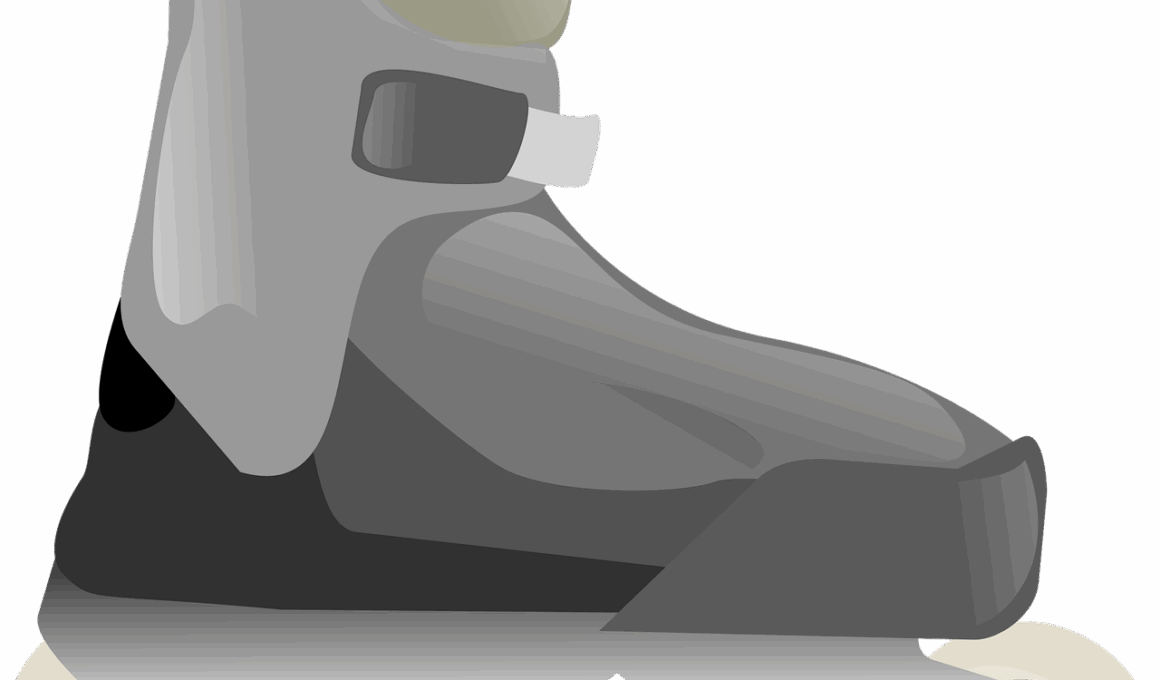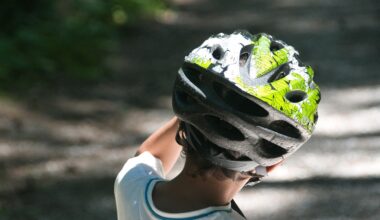How to Improve Your Inline Skating Posture and Form
To achieve better inline skating skills, posture and form are critical aspects to focus on. A proper stance helps maintain balance, power, and control while skating. Start by standing with your feet shoulder-width apart and knees slightly bent. This creates a stable base that allows you to respond quickly to shifts in weight. Keep your hips centered over your skates, which helps maintain an even distribution of weight when attempting turns or stops. Remember to engage your core muscles; a strong core is essential for supporting your spine. When skating, try to keep your upper body relaxed and upright, as this distributes the movements of your arms and legs evenly. Avoid leaning too far forward or backward, as doing so can lead to instability. Keep your shoulders back and your head up, looking forward rather than down at your skates. Incorporating these elements into your routine can significantly enhance performance. Lastly, practicing regularly on different terrains can also improve your overall balance and agility, enabling you to feel comfortable and confident on your skates.
Another essential component to examine is your foot placement while skating. Your feet should be placed correctly on the skates to allow for optimal movement and efficiency. Begin by ensuring that your feet are aligned with the wheels of the skates, avoiding any excessive angles. When pushing off, aim to apply pressure to the outside edges of your skates. This pressure provides better grip and traction, giving you increased speed and stability. Remember to avoid overextending your legs during a stride, as it can lead to fatigue and imbalance. Practice making long, powerful strides while keeping your feet close to the ground to enhance your efficiency. Skating drills focusing on foot placement can also help to reinforce your habit. Try alternating between quick, short steps and longer, more powerful strides. You can also use cone drills to work on making fast transitions while maintaining proper foot placement. Balancing your stride, speed, and foot placement will allow you to harness your energy more effectively, which leads to improved performance in the long run.
Techniques to Enhance Your Inline Skating
Once you’ve established a solid foundation in posture and foot placement, it’s time to enhance your techniques. Incorporate various skating drills that focus on acceleration, turns, and stopping effectively, as this will benefit your overall skating ability. Skaters should practice the T-stop and the plow stop to improve stopping techniques. The T-stop requires dragging one skate behind the other, while the plow stop involves pushing outwards with both feet, slowing down gradually. Practicing these stops regularly ensures that you’re confident stopping at different speeds and in various conditions. In addition to stopping techniques, improve your turning abilities by working on the crossover method. This involves shifting your weight from one skate to the other while bringing the opposite foot across during turns. Learning how to pivot effectively will significantly enhance your skating experience. Incorporating skating drills that emphasize these techniques into your practice can accelerate your progress. Over time, you’ll notice an increase in your control, speed, and overall performance on your inline skates.
Inlining also requires conditioning your muscles adequately, leading to longer skating sessions. Focus on strengthening your leg muscles, particularly the quadriceps and hamstrings, as they are crucial for balance and power while skating. Lunges, squats, and leg presses are effective exercises to build strength in these areas. Flexibility is equally critical; incorporating stretching into your routine will ensure that your muscles remain elongated and pain-free. Stretching can prevent injuries by maintaining flexibility in your joints and muscles. Aerobic conditioning will also play an essential role; consider activities like running, cycling, or swimming to build cardiovascular endurance. A strong heart and lungs will help you skate longer distances without fatigue. Incorporate interval training for aerobic conditioning, alternating between intense bursts of skating and slower-paced intervals. By improving your overall fitness level, you’ll enhance your skating performance dramatically. As your strength and endurance improve, you’ll find your skills becoming more effortless, allowing you to enjoy inline skating even more.
Biomechanics of Inline Skating
Understanding the biomechanics behind inline skating can lead to further improvements in both posture and form. Biomechanics refers to the mechanical principles that govern movement within the human body. Skaters need to align their joints effectively to optimize their skating performance. Start with your ankles; they should exhibit a natural range of motion to allow you to transfer power efficiently from your legs to the skates. This means maintaining a slight forward lean while keeping your heels grounded for proper stability. Your knees should align with your toes for effective energy transfer during a push-off. Avoid letting your knees buckle inward, as this can lead to injuries and reduced power. Your hips should remain level and square while skating; this alignment helps to maintain a stable backbone throughout your movements. Additionally, your upper body should maintain a relaxed posture to avoid tension while skating. Practicing this alignment may require conscious effort but will soon become second nature, significantly enhancing your overall skating experience and efficiency.
In-line skating is not only about physical aspects; mental focus plays an important role in improving performance. Set achievable goals to help build your skating skills progressively. Visualize each skating session, keeping your desired posture and movement in mind, as this helps solidify muscle memory. When attempting new techniques, break them down into manageable components. Learning gradually allows you to concentrate on mastering smaller elements. Consider practicing in front of a mirror or recording yourself to better observe your form, allowing you to screen areas for improvement. This feedback will assist in transforming your skating technique significantly. Remember to also stay patient with your progress; improvement won’t happen overnight. Regular practice, along with the focus on form and technique, will yield positive results over time. Discussions with fellow skaters or coaches can also provide valuable insights and motivation. Learning from others’ experiences and tips may lead to performance breakthroughs you might not have encountered on your own. Stay engaged in the skating community to discover tips and techniques continually.
Maintaining Gear and Safety Tips
Acquiring the right inline skating gear is a crucial aspect of enhancing your performance. Begin with a pair of high-quality skates designed for your skill level. Ensure they fit properly without being too tight or loose. A good fit will provide the necessary support and control over your movements. In addition, wearing protective gear is essential for safety and reducing the risk of injury while skating. Make sure to invest in a quality helmet, knee pads, elbow pads, and wrist guards to protect your body from falls and impacts. Regularly inspect your equipment for wear and tear, as worn wheels or brakes can hinder performance. Replace damaged parts promptly to ensure peak efficiency during your sessions. It’s also important to stay aware of your surroundings while skating. Choose safe environments such as parks or designated skating paths to minimize collisions with pedestrians or vehicles. Make sure to signal your direction when turning or stopping, so others are aware of your movements. Practicing these safety tips not only keeps you safe but helps you maintain your focus on improving your inline skating skills.


